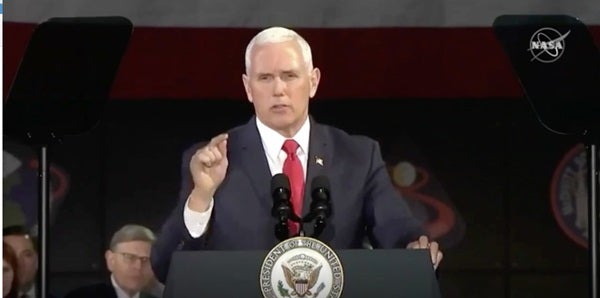“The first woman and the next man on the Moon will both be American astronauts launched by American rockets from American soil,” he pledged. It’s an audacious pledge, given NASA’s current capabilities, and especially in light of recent setbacks to the Space Launch System (SLS), the agency’s long-delayed and over-budget heavy lift rocket. If NASA faces difficulties with that timeline, Pence said, “We need to change the organization, not the mission.” How this will affect NASA’s wide host of other goals, from astrophysics to education, remains unknown.
‘By Any Means Necessary’
Pence acknowledged that SLS, NASA’s heavy-lift rocket currently under construction, is vital for a return to the Moon. NASA administrator Jim Bridenstine recently admitted that SLS’s schedule has slipped, and that its first planned missions, slated for next year, may instead be launched by commercial rockets.
Pence said that the SLS plans should be accelerated to meet the 2024 lunar objective, “by any means necessary.” But he also laid out the possibility of changing contractors, should current ones not be able to meet demands. It’s a veiled threat to Boeing, which is currently contracted to build SLS, and is being held responsible for the schedule delays. Pence also stated that, “If commercial rockets are the only way to get Americans to the Moon in the next five years, then commercial it will be.”
In terms of mission goals, Pence agreed with NASA’s broad goals of exploring the Moon’s South Pole, vowing that it would be the first landing site in a new era of human lunar exploration. The South Pole is largely unexplored in general, and humans have never walked there. NASA has long highlighted it as a key location to understanding the Moon’s geology and history, and it is likely a rich source of water, which will be invaluable for long-term activities on the Moon.
Bridenstine, for his part, promised a streamlined approach to the lunar goals, including no extra testing for SLS. “We are only doing what is necessary to get to first launch,” he stated. He promised that SLS would fly Exploratory Mission 3. It’s a mission currently planned for 2024 that would deliver astronauts into a lunar orbit, as well as cargo to continue building the Lunar Gateway space station. SLS was originally intended for all the EM flights, but the administration has recently prioritized the flights themselves, even on commercial rockets, over flying them on NASA’s own SLS.
The review by the space council also mentioned the administration’s plans for Trump’s proposed Space Force. General John Raymond, currently of the Air Force, was named the new leader of Space Command. Trump can authorize the creation of Space Command, which currently resides within the Air Force. However, the creation of a separate Space Force, equivalent to the other military branches, would require a vote by Congress.
Heather Wilson, secretary of the Air Force, said during today’s council meeting that she expects to stand up an initial Space Force organization within the Air Force over the next few years, and then transfer it to an independent organization once legislation is passed.










